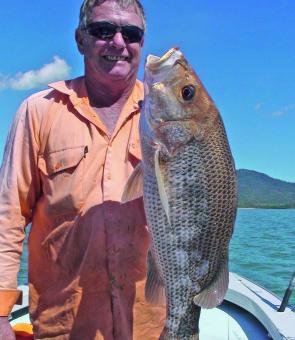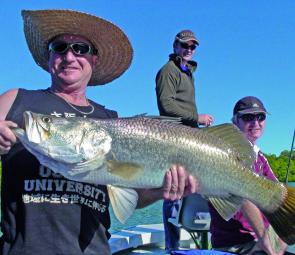The fishing at Hinchinbrook lately has been the best I have seen yet. Both barra and fingermark catches have been outstanding and we are still catching some nice threadfin as well.
I have had many new southern clients taking advantage of the fishing/accommodation specials available at Port Hinchinbrook and the fishing has not let them down. Some recent fingermark captures have been excellent with fish in the estuaries up to 5kg. I have had some good reports from the locals who fish the area’s better known hotspots, with one angler reporting a trip of around 25 fish during the evening hours. Good to see most were released!
The winter barra have also sprung to life and I’m now catching fish up on the higher ledges rather than the deeper holes they frequented in summer. I have found that 90cm is the average school size for this area. One of the most favoured baits in the past month has been mud herring and there has been no shortage of them, especially at the northern end of the channel. Mud herring have also accounted for many of our threadfin captures in recent months.
There have been sporadic reports of some big golden grunter during the past month, but most have come from deeper headland waters rather than the estuaries. I will have to get out and have a go at them as they are one of my favourite tablefish. The making tides up to the next new moon should do the trick.
Hinchinbrook reef operators Scott Hillier and Mick Edwards have both reported bunches of Spaniards at the inner reefs and bait schools in the shipping lanes. Looks like one of the best seasons for Spaniards for some time, as recent years weren’t quite up to scratch. The islands have also seen some good Spaniards, and by July most mackerel will be inshore. Trolling a gar behind a woghead or plastic squid is a popular method for Spaniards, as is casting and retrieving large metal slices, especially when the run stops. Spaniards also like the period of tides up to the new moon.
In July the Spaniards will remain a popular target and many anglers will also turn to bread-and-butter species such as bream, grunter and flathead. The annual run of the smaller mackerel species such as doggies will no doubt keep many of the region’s fishers occupied during winter.
I’m hoping that we might also see some big cobia show up in Missionary Bay. A simple berley trail out in 4-5m of water on the run-out tide is your best bet, particularly around both moons. The cobes will respond to a variety of baits, from livies to unweighted pillies. Of course, it’s always handy to have a soft plastic at the ready, too, as the fish can often be seen swimming up the berley trail before they take a bait.
This month I’m looking forward to fishing some of the crevices I have found in the Hinchinbrook Channel by using my Hummingbird 997 sidescanner. I can’t praise that toy enough as it has made finding new spots a whole lot easier.
On a sour note though, Environment Minister Peter Garrett has announced an east coast bio-regional management plan. This will be the beginning of further closures, starting with a management plan for the entire Coral Sea! No doubt the review of the GBR Marine Park in July 2011 will be an interesting one, too, if the leaks from GBRMPA are correct. If the current green zones are increased it will put great pressure on other areas, and will hurt the recreational fishing industry and coastal towns. It’s a similar story along the south-east coast and NSW, sadly.
So, with this in mind, I recommend that you come up and experience North Queensland’s fishing before many of the experienced operators shut down. If you would like some info on the fishing/accommodation specials at Port Hinchinbrook call Robyn at Inspiration Resort on (07) 4066 2250.
[CAPTIONS]
1.
Some top fingermark have been caught over the past month.
2.
Early winter barra have been hitting baits aggressively.
Reads: 1663





